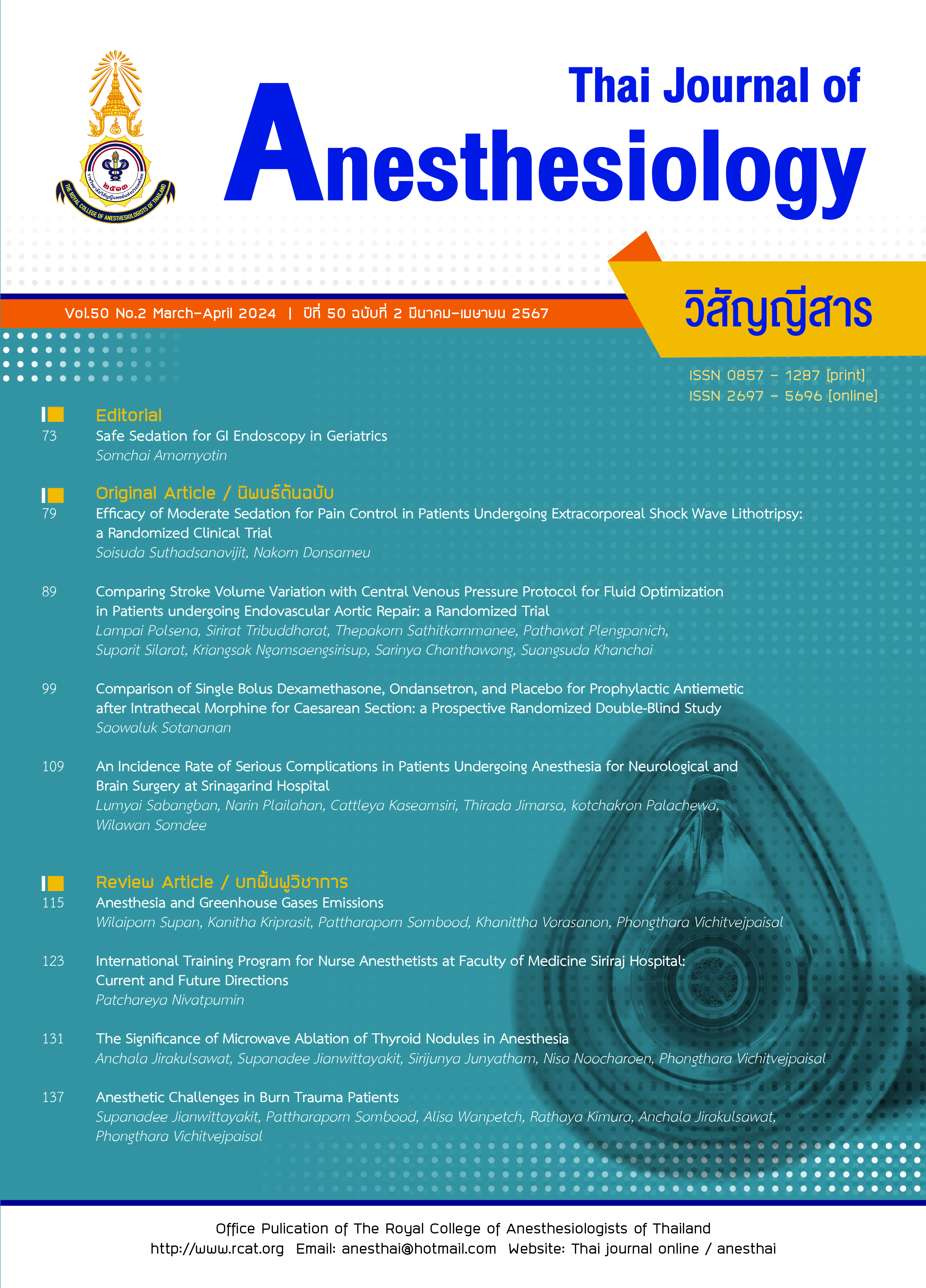Comparing Stroke Volume Variation with Central Venous Pressure Protocol for Fluid Optimization in Patients undergoing Endovascular Aortic Repair: a Randomized Trial
Main Article Content
Abstract
Objectives: To compare postoperative arterial lactate level, as well as hemodynamic parameters and clinical outcomes, between patients undergoing endovascular aortic repair (EVAR) who were managed with either stroke volume variation (SVV) or central venous pressure (CVP) protocol for fluid optimization. Methods: This is a prospective double-blinded randomized trial. Sixty adult patients underwent elective EVAR, both abdominal and thoracic surgeries in two cardiac centers (Queen Sirikit Heart Center of the Northeast and Srinagarind Hospital, Khon Kaen University). All patients were randomized into two groups with 30 patients each. Intraoperatively, fluid optimization in group CVP was managed using the CVP guided protocol, while the SVV protocol was used for group SVV. Results: Group SVV had a lower arterial lactate level immediately after surgery (1.2±0.6 vs 1.8±1.0 mg/dL, P=0.044). Over the first 48 h postoperatively, there were no significant differences in lactate or creatinine between groups. There was an inverse correlation between SVV and the cardiac index (CI) and between CVP and CI. No correlation was found between SVV and CVP. Conclusion: Use of the SVV over against the CVP guidance for fluid optimization in patients undergoing EVAR results in a lower arterial lactate level. SVV has a good inverse correlation with CI which confirms that SVV is a useful guide for fluid therapy while CVP has no correlation with SVV and shows a negative instead of positive correlation with CI, and thus should not be used as a guide for fluid optimization.
Article Details

This work is licensed under a Creative Commons Attribution-NonCommercial-NoDerivatives 4.0 International License.
References
Scheeren TW, Wiesenack C, Gerlach H, Marx G. Goal-directed intraoperative fluid therapy guided by stroke volume and its variation in high-risk surgical patients: a prospective randomized multicentre study. J Clin Monit Comput. 2013;27:225-33.
Hughes RE, Magovern GJ. The relationship between right atrial pressure and blood volume. AMA Arch Surg. 1959;79:238-43.
Dellinger RP, Carlet JM, Masur H, et al. Surviving Sepsis Campaign guidelines for management of severe sepsis and septic shock. Crit Care Med. 2004;32:858-73.
Dellinger RP, Levy MM, Carlet JM, et al. Surviving Sepsis Campaign: international guidelines for management of severe sepsis and septic shock: 2008. Crit Care Med. 2008;36:296-327.
Dellinger RP, Levy MM, Rhodes A, et al. Surviving sepsis campaign: international guidelines for management of severe sepsis and septic shock: 2012. Crit Care Med. 2013;41:580-637.
Rhodes A, Evans LE, Alhazzani W, et al. Surviving Sepsis Campaign: international guidelines for management of sepsis and septic shock: 2016. Crit Care Med. 2017;45:486-552.
Hu B, Xiang H, Liang H, et al. Assessment effect of central venous pressure in fluid resuscitation in the patients with shock: a multi-center retrospective research. Chin Med J (Engl). 2013;126:1844-9.
Marik PE, Baram M, Vahid B. Does central venous pressure predict fluid responsiveness? A systematic review of the literature and the tale of seven mares. Chest. 2008;134:172-8.
Marik PE, Cavallazzi R. Does the central venous pressure predict fluid responsiveness? An updated meta-analysis and a plea for some common sense. Crit Care Med. 2013;41:1774-81.
Zhang Z, Lu B, Sheng X, Jin N. Accuracy of stroke volume variation in predicting fluid responsiveness: a systematic review and meta-analysis. J Anesth. 2011;25:904-16.
Rathore A, Singh S, Lamsal R, Taank P, Paul D. Validity of pulse pressure variation (PPV) compared with stroke volume variation (SVV) in predicting fluid responsiveness. Turk J Anaesthesiol Reanim. 2017;45:210-7.
Kothandan H, Chieh GLH, Khan SA, Karthekeyan RB, Sharad SS. Anesthetic considerations for endovascular abdominal aortic aneurysm repair. Ann Card Anaesth. 2016;19:132-41.
Benes J, Chytra I, Altmann P, et al. Intraoperative fluid optimization using stroke volume variation in high risk surgical patients: results of prospective randomized study. Crit Care. 2010;14:R118.
Hofer CK, Button D, Weibel L, Genoni M, Zollinger A. Uncalibrated radial and femoral arterial pressure waveform analysis for continuous cardiac output measurement: an evaluation in cardiac surgery patients. J Cardiothorac Vasc Anesth. 2010;24:257-64.
Kapoor PM, Magoon R, Rawat R, Mehta Y. Peri-operative utility of goal-directed therapy in high-risk cardiac patients undergoing coronary artery bypass grafting: “A clinical outcome and biomarker-based study”. Ann Card Anaesth. 2016;19:638-82.
Mayer J, Boldt J, Mengistu AM, Rohm KD, Suttner S. Goal-directed intraoperative therapy based on autocalibrated arterial pressure waveform analysis reduces hospital stay in high-risk surgical patients: a randomized, controlled trial. Crit Care. 2010;14:R18.
Arulkumaran N, Corredor C, Hamilton MA, et al. Cardiac complications associated with goal-directed therapy in high-risk surgical patients: a meta-analysis. Br J Anaesth. 2014;112:648-59.
Lopes MR, Oliveira MA, Pereira VOS, Lemos IPB, Auler Jr JOC, Michard F. Goal-directed fluid management based on pulse pressure variation monitoring during high-risk surgery: a pilot randomized controlled trial. Crit Care. 2007;11:R100.
Walsh SR, Bhutta H, Tang TY, et al. Anaesthetic specialisation leads to improved early- and medium-term survival following major vascular surgery. Eur J Vasc Endovasc Surg. 2010;39:719-25.
Marik PE, Monnet X, Teboul JL. Hemodynamic parameters to guide fluid therapy. Ann Intensive Care. 2011;1:1.


